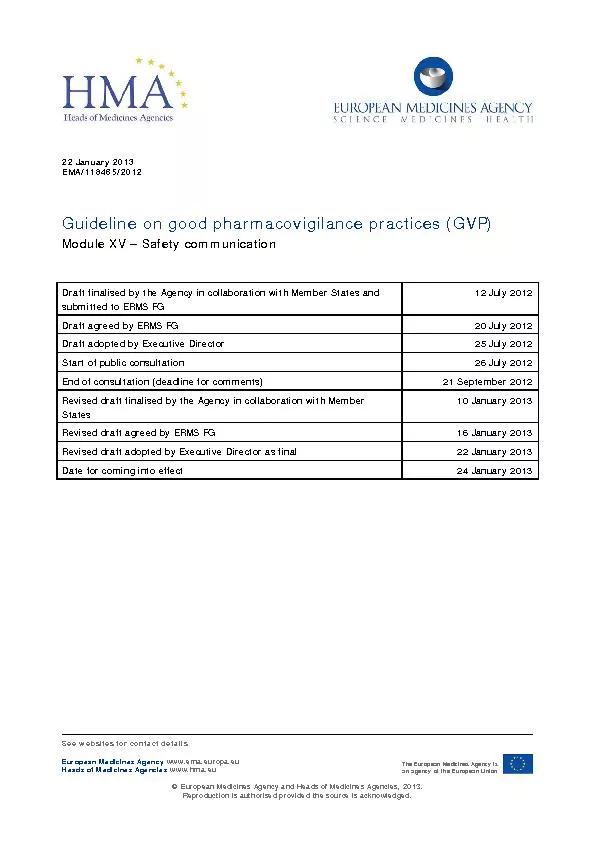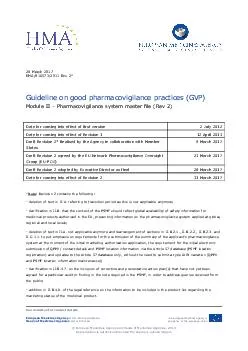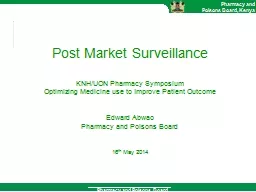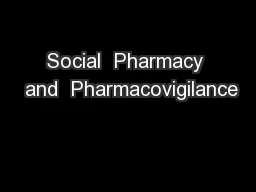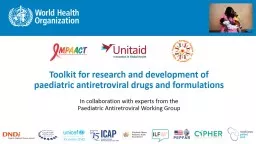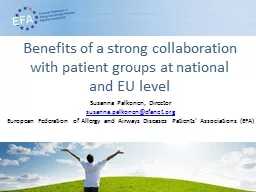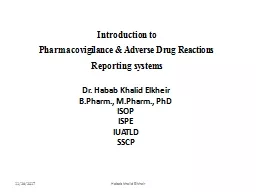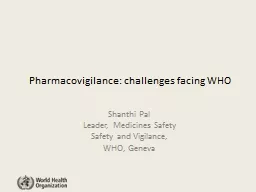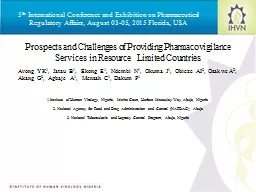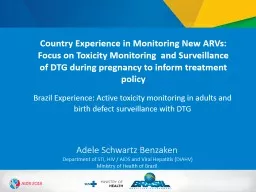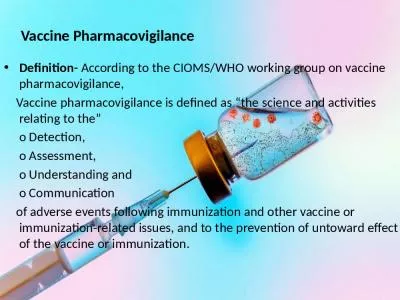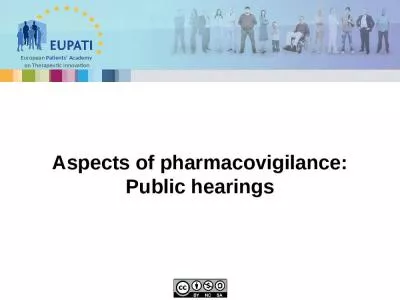PPT-Introduction to pharmacovigilance
Author : ellena-manuel | Published Date : 2018-12-21
Monitoring the safety of medicines Pharmacovigilance is the science and practices related to the detection assessment understanding and prevention of adverse effects
Presentation Embed Code
Download Presentation
Download Presentation The PPT/PDF document "Introduction to pharmacovigilance" is the property of its rightful owner. Permission is granted to download and print the materials on this website for personal, non-commercial use only, and to display it on your personal computer provided you do not modify the materials and that you retain all copyright notices contained in the materials. By downloading content from our website, you accept the terms of this agreement.
Introduction to pharmacovigilance: Transcript
Monitoring the safety of medicines Pharmacovigilance is the science and practices related to the detection assessment understanding and prevention of adverse effects or any other medicinerelated problem. If you have a question on signal managem ent that is not addressed in this document please send it to pv helpdeskemaeuropaeu Note his document has been produced for guidance only and should be read in conjunction with Directive 200183EC Regulation E Draft agreed by ERMS FG20 July 2012 Draft adopted by Executive Director25 July 2012 Start of public consultation6 July 2012 End of consultation (deadline for comments)21 September 2012 Revised draft f 9 April EMA/816573/2011Rev 1* Draft agreed by ERMS FG24 January 2012 Draft adopted by Executive Director20 February 2012 Released for consultation21 February 2012 End of consultation (deadline for co KNH/UON . Pharmacy Symposium. Optimizing Medicine use to Improve Patient Outcome. Edward . Abwao. Pharmacy and Poisons Board. 16. th. May 2014 . Post Market Surveillance: Definition. Post-market surveillance refers . . Dr Madhava Ram. Medical Officer. EMP/ SAV. Unsafe vaccine can have serious consequences. Safety crises derail immunization programs. Real incidents:. Intussusception following Rotavirus vaccine.. Polio following IPV.. JAMASOFT2017. 1. Social. Pharmacy. Pharmacoepidemiology. Pharmacovigilance. JAMASOFT2017. 2. P. armacovigilance. system collects data . throughout the . lifecycle . of each . medicinal. . product. Module 10:. Pharmacovigilance. Background – definitions. Timeline of pharmacovigilance for a drug from development (pre-market) to post-marketing use. Burden of adverse drug reactions in children. Number of pharmacoepidemiological safety studies in children (Osokogu et al, 2016). at national . and EU level. Susanna Palkonen, Director . susanna.palkonen. @efanet.org. . European Federation of Allergy and Airways Diseases Patients’ Associations (EFA). Who is EFA?. The European Federation of Allergy and Airways Diseases Patients’ Associations (EFA). & . Adverse Drug Reactions . Reporting systems. Dr. . Habab. Khalid . Elkheir. B.Pharm. ., . M.Pharm. ., PhD . ISOP. ISPE. IUATLD. SSCP. 11/28/2017. Habab khalid Elkheir. Objectives of the workshop. Shanthi Pal. Leader, Medicines Safety. Safety . and Vigilance,. WHO, Geneva. What is pharmacovigilance. The science and activities relating to the detection, assessment, understanding and prevention of . Prospects and Challenges of Providing Pharmacovigilance Services in Resource Limited Countries Avong YK 1 , Jatau B 1 , Ekong E 1 , Ndembi N 1 , Okuma J 1 , Obieze AI 2 , Osakwe A 2 , ARVs: Focus on Toxicity Monitoring . and Surveillance of DTG during pregnancy to inform treatment policy . Adele Schwartz Benzaken. . Department . of . STI, . HIV/AIDS . and Viral . Hepatitis. Ministry . Definition- . According to the CIOMS/WHO working group on vaccine pharmacovigilance, . Vaccine . pharmacovigilance is defined as “the science and activities relating to the” . . o . Detection, . A public hearing is a forum to which the public is invited to express its views and concerns on a pre-defined set of questions on issues related to the safety of a particular medicine while also considering its therapeutic effects..
Download Document
Here is the link to download the presentation.
"Introduction to pharmacovigilance"The content belongs to its owner. You may download and print it for personal use, without modification, and keep all copyright notices. By downloading, you agree to these terms.
Related Documents


